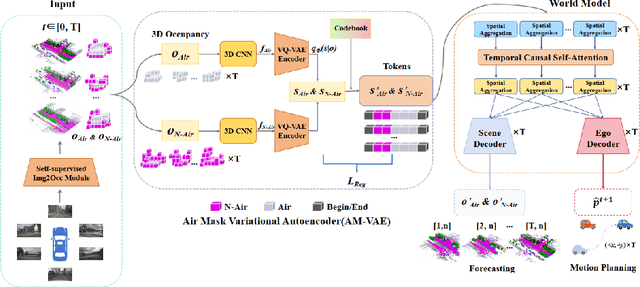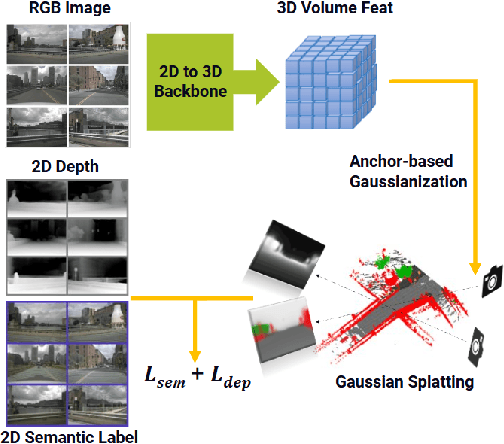Haozhe Wang
Zero-shot Autonomous Microscopy for Scalable and Intelligent Characterization of 2D Materials
Apr 14, 2025Abstract:Characterization of atomic-scale materials traditionally requires human experts with months to years of specialized training. Even for trained human operators, accurate and reliable characterization remains challenging when examining newly discovered materials such as two-dimensional (2D) structures. This bottleneck drives demand for fully autonomous experimentation systems capable of comprehending research objectives without requiring large training datasets. In this work, we present ATOMIC (Autonomous Technology for Optical Microscopy & Intelligent Characterization), an end-to-end framework that integrates foundation models to enable fully autonomous, zero-shot characterization of 2D materials. Our system integrates the vision foundation model (i.e., Segment Anything Model), large language models (i.e., ChatGPT), unsupervised clustering, and topological analysis to automate microscope control, sample scanning, image segmentation, and intelligent analysis through prompt engineering, eliminating the need for additional training. When analyzing typical MoS2 samples, our approach achieves 99.7% segmentation accuracy for single layer identification, which is equivalent to that of human experts. In addition, the integrated model is able to detect grain boundary slits that are challenging to identify with human eyes. Furthermore, the system retains robust accuracy despite variable conditions including defocus, color temperature fluctuations, and exposure variations. It is applicable to a broad spectrum of common 2D materials-including graphene, MoS2, WSe2, SnSe-regardless of whether they were fabricated via chemical vapor deposition or mechanical exfoliation. This work represents the implementation of foundation models to achieve autonomous analysis, establishing a scalable and data-efficient characterization paradigm that fundamentally transforms the approach to nanoscale materials research.
VL-Rethinker: Incentivizing Self-Reflection of Vision-Language Models with Reinforcement Learning
Apr 10, 2025Abstract:Recently, slow-thinking systems like GPT-o1 and DeepSeek-R1 have demonstrated great potential in solving challenging problems through explicit reflection. They significantly outperform the best fast-thinking models, such as GPT-4o, on various math and science benchmarks. However, their multimodal reasoning capabilities remain on par with fast-thinking models. For instance, GPT-o1's performance on benchmarks like MathVista, MathVerse, and MathVision is similar to fast-thinking models. In this paper, we aim to enhance the slow-thinking capabilities of vision-language models using reinforcement learning (without relying on distillation) to advance the state of the art. First, we adapt the GRPO algorithm with a novel technique called Selective Sample Replay (SSR) to address the vanishing advantages problem. While this approach yields strong performance, the resulting RL-trained models exhibit limited self-reflection or self-verification. To further encourage slow-thinking, we introduce Forced Rethinking, which appends a textual rethinking trigger to the end of initial rollouts in RL training, explicitly enforcing a self-reflection reasoning step. By combining these two techniques, our model, VL-Rethinker, advances state-of-the-art scores on MathVista, MathVerse, and MathVision to achieve 80.3%, 61.8%, and 43.9% respectively. VL-Rethinker also achieves open-source SoTA on multi-disciplinary benchmarks such as MMMU-Pro, EMMA, and MEGA-Bench, narrowing the gap with GPT-o1.
Grasping by Spiraling: Reproducing Elephant Movements with Rigid-Soft Robot Synergy
Apr 02, 2025Abstract:The logarithmic spiral is observed as a common pattern in several living beings across kingdoms and species. Some examples include fern shoots, prehensile tails, and soft limbs like octopus arms and elephant trunks. In the latter cases, spiraling is also used for grasping. Motivated by how this strategy simplifies behavior into kinematic primitives and combines them to develop smart grasping movements, this work focuses on the elephant trunk, which is more deeply investigated in the literature. We present a soft arm combined with a rigid robotic system to replicate elephant grasping capabilities based on the combination of a soft trunk with a solid body. In our system, the rigid arm ensures positioning and orientation, mimicking the role of the elephant's head, while the soft manipulator reproduces trunk motion primitives of bending and twisting under proper actuation patterns. This synergy replicates 9 distinct elephant grasping strategies reported in the literature, accommodating objects of varying shapes and sizes. The synergistic interaction between the rigid and soft components of the system minimizes the control complexity while maintaining a high degree of adaptability.
TR-DQ: Time-Rotation Diffusion Quantization
Mar 09, 2025Abstract:Diffusion models have been widely adopted in image and video generation. However, their complex network architecture leads to high inference overhead for its generation process. Existing diffusion quantization methods primarily focus on the quantization of the model structure while ignoring the impact of time-steps variation during sampling. At the same time, most current approaches fail to account for significant activations that cannot be eliminated, resulting in substantial performance degradation after quantization. To address these issues, we propose Time-Rotation Diffusion Quantization (TR-DQ), a novel quantization method incorporating time-step and rotation-based optimization. TR-DQ first divides the sampling process based on time-steps and applies a rotation matrix to smooth activations and weights dynamically. For different time-steps, a dedicated hyperparameter is introduced for adaptive timing modeling, which enables dynamic quantization across different time steps. Additionally, we also explore the compression potential of Classifier-Free Guidance (CFG-wise) to establish a foundation for subsequent work. TR-DQ achieves state-of-the-art (SOTA) performance on image generation and video generation tasks and a 1.38-1.89x speedup and 1.97-2.58x memory reduction in inference compared to existing quantization methods.
Knowledge-enhanced Multimodal ECG Representation Learning with Arbitrary-Lead Inputs
Feb 25, 2025Abstract:Recent advances in multimodal ECG representation learning center on aligning ECG signals with paired free-text reports. However, suboptimal alignment persists due to the complexity of medical language and the reliance on a full 12-lead setup, which is often unavailable in under-resourced settings. To tackle these issues, we propose **K-MERL**, a knowledge-enhanced multimodal ECG representation learning framework. **K-MERL** leverages large language models to extract structured knowledge from free-text reports and employs a lead-aware ECG encoder with dynamic lead masking to accommodate arbitrary lead inputs. Evaluations on six external ECG datasets show that **K-MERL** achieves state-of-the-art performance in zero-shot classification and linear probing tasks, while delivering an average **16%** AUC improvement over existing methods in partial-lead zero-shot classification.
AURORA:Automated Training Framework of Universal Process Reward Models via Ensemble Prompting and Reverse Verification
Feb 17, 2025Abstract:The reasoning capabilities of advanced large language models (LLMs) like o1 have revolutionized artificial intelligence applications. Nevertheless, evaluating and optimizing complex reasoning processes remain significant challenges due to diverse policy distributions and the inherent limitations of human effort and accuracy. In this paper, we present AURORA, a novel automated framework for training universal process reward models (PRMs) using ensemble prompting and reverse verification. The framework employs a two-phase approach: First, it uses diverse prompting strategies and ensemble methods to perform automated annotation and evaluation of processes, ensuring robust assessments for reward learning. Second, it leverages practical reference answers for reverse verification, enhancing the model's ability to validate outputs and improving training accuracy. To assess the framework's performance, we extend beyond the existing ProcessBench benchmark by introducing UniversalBench, which evaluates reward predictions across full trajectories under diverse policy distribtion with long Chain-of-Thought (CoT) outputs. Experimental results demonstrate that AURORA enhances process evaluation accuracy, improves PRMs' accuracy for diverse policy distributions and long-CoT responses. The project will be open-sourced at https://auroraprm.github.io/. The Universal-PRM-7B is available at https://huggingface.co/infly/Universal-PRM-7B.
ACECODER: Acing Coder RL via Automated Test-Case Synthesis
Feb 03, 2025Abstract:Most progress in recent coder models has been driven by supervised fine-tuning (SFT), while the potential of reinforcement learning (RL) remains largely unexplored, primarily due to the lack of reliable reward data/model in the code domain. In this paper, we address this challenge by leveraging automated large-scale test-case synthesis to enhance code model training. Specifically, we design a pipeline that generates extensive (question, test-cases) pairs from existing code data. Using these test cases, we construct preference pairs based on pass rates over sampled programs to train reward models with Bradley-Terry loss. It shows an average of 10-point improvement for Llama-3.1-8B-Ins and 5-point improvement for Qwen2.5-Coder-7B-Ins through best-of-32 sampling, making the 7B model on par with 236B DeepSeek-V2.5. Furthermore, we conduct reinforcement learning with both reward models and test-case pass rewards, leading to consistent improvements across HumanEval, MBPP, BigCodeBench, and LiveCodeBench (V4). Notably, we follow the R1-style training to start from Qwen2.5-Coder-base directly and show that our RL training can improve model on HumanEval-plus by over 25\% and MBPP-plus by 6\% for merely 80 optimization steps. We believe our results highlight the huge potential of reinforcement learning in coder models.
Passive Six-Dimensional Movable Antenna (6DMA)-Assisted Multiuser Communication
Dec 06, 2024Abstract:Six-dimensional movable antenna (6DMA) is a promising solution for enhancing wireless network capacity through the adjustment of both three-dimensional (3D) positions and 3D rotations of distributed antenna surfaces. Previous works mainly consider 6DMA surfaces composed of active antenna elements, thus termed as active 6DMA. In this letter, we propose a new passive 6DMA system consisting of distributed passive intelligent reflecting surfaces (IRSs) that can be adjusted in terms of 3D position and 3D rotation. Specifically, we study a passive 6DMA-aided multiuser uplink system and aim to maximize the users' achievable sum rate by jointly optimizing the 3D positions, 3D rotations, and reflection coefficients of all passive 6DMA surfaces, as well as the receive beamforming matrix at the base station (BS). To solve this challenging non-convex optimization problem, we propose an alternating optimization (AO) algorithm that decomposes it into three subproblems and solves them alternately in an iterative manner. Numerical results are presented to investigate the performance of the proposed passive 6DMA system under different configurations and demonstrate its superior performance over the traditional fixed-IRS counterpart for both directive and isotropic radiation patterns of passive reflecting elements.
Can Medical Vision-Language Pre-training Succeed with Purely Synthetic Data?
Oct 17, 2024



Abstract:Medical Vision-Language Pre-training (MedVLP) has made significant progress in enabling zero-shot tasks for medical image understanding. However, training MedVLP models typically requires large-scale datasets with paired, high-quality image-text data, which are scarce in the medical domain. Recent advancements in Large Language Models (LLMs) and diffusion models have made it possible to generate large-scale synthetic image-text pairs. This raises the question: *Can MedVLP succeed using purely synthetic data?* To address this, we use off-the-shelf generative models to create synthetic radiology reports and paired Chest X-ray (CXR) images, and propose an automated pipeline to build a diverse, high-quality synthetic dataset, enabling a rigorous study that isolates model and training settings, focusing entirely from the data perspective. Our results show that MedVLP models trained *exclusively on synthetic data* outperform those trained on real data by **3.8%** in averaged AUC on zero-shot classification. Moreover, using a combination of synthetic and real data leads to a further improvement of **9.07%**. Additionally, MedVLP models trained on synthetic or mixed data consistently outperform those trained on real data in zero-shot grounding, as well as in fine-tuned classification and segmentation tasks. Our analysis suggests MedVLP trained on well-designed synthetic data can outperform models trained on real datasets, which may be limited by low-quality samples and long-tailed distributions.
RenderWorld: World Model with Self-Supervised 3D Label
Sep 17, 2024



Abstract:End-to-end autonomous driving with vision-only is not only more cost-effective compared to LiDAR-vision fusion but also more reliable than traditional methods. To achieve a economical and robust purely visual autonomous driving system, we propose RenderWorld, a vision-only end-to-end autonomous driving framework, which generates 3D occupancy labels using a self-supervised gaussian-based Img2Occ Module, then encodes the labels by AM-VAE, and uses world model for forecasting and planning. RenderWorld employs Gaussian Splatting to represent 3D scenes and render 2D images greatly improves segmentation accuracy and reduces GPU memory consumption compared with NeRF-based methods. By applying AM-VAE to encode air and non-air separately, RenderWorld achieves more fine-grained scene element representation, leading to state-of-the-art performance in both 4D occupancy forecasting and motion planning from autoregressive world model.
 Add to Chrome
Add to Chrome Add to Firefox
Add to Firefox Add to Edge
Add to Edge